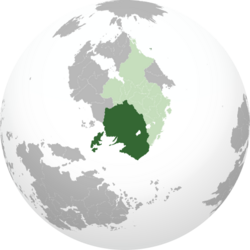Netansett
This article is a work-in-progress because it is incomplete and pending further input from an author. Note: The contents of this article are not considered canonical and may be inaccurate. Please comment on this article's talk page to share your input, comments and questions. |
Republic of Iriquona Your Country in Another Language (Your language) | |
|---|---|
Motto: Your motto, often in another language ("Your motto in English") | |
Anthem: Your song | |
 Location of XXX (dark green) In XXX (gray) | |
| Capital | Your city |
| Largest city | Your largest city (type "capital" for it to say "Capital and largest city") |
| Official languages | Your language Your language |
| Religion | Your religion |
| Demonym(s) | XXXan (noun) XXXan (adjective) |
| Government | Your government type |
• Your head of state | Joe Blow |
• Your head of government if applicable, otherwise a legislative leader | Jane Blow |
• A legislative leader of a different house, if applicable | Georgw Blow |
| Your upper house | |
| Your lower house | |
| Establishment | |
• Establishment of the Hukon League | 1764 |
• Independence from Kiravia | A date |
• Modern constitution | A date |
| Population | |
• Estimate | Your population |
| GDP (nominal) | estimate |
• Total | Your GDP = GDPPC x Population (This is calculated for you after first entry) |
• Per capita | Your GDP PC |
| Currency | Your Currency |
Iriquona, officially the Republic of Iriquona, is a country in Cusinaut. It is neighbored by Porfíria, New Harren, Sabnaki, and the Algosh Republic.
For most of human history, Iriquona was settled by a large number of diverse peoples. The indigineous people of the country lived in a mostly tribal, mostly-migratory manner, trading with the more settled peoples of Cusinaut while retaining their hunter-gatherer lifestyle. The arrival of Kiravia and establishment of the nearby colony of Porfíria initially changed very little, but by the 18th century the area of modern Iriquona became part of Porfírian colonial claims. The eight largest local tribes established the Hukon League, which eventually became the official representative of indigienous people in the territory claimed by Kiravia; it concluded the Treaty of Vittēmur in 1773, which created a line beyond which Occidentals could not settle. The Vittēmur line eventually became a jurisdictional boundary between the colonial Porfírian government and the Hukon League, and today forms Iriquona's southern border. During the 19th century, the Hukon League would begin social and political integration of its various constituent elements while also gradually gaining further autonomy from the Porfírian colonial government.
Etymology
Iriquona is the traditional native name for the geographic region the country occupies, translating roughly as "wooded hills". For a time, the country was known internationally as "Huconia" due to the nation's historic association with the Hukon League, but by 1910 this terminology had been disavowed as the name was largely a Coscivian exonym. The Hukon League's name derived from the Treaty of Hukon, then a major village in modern Iriquona. The term was never officially adopted by the people of Iriquona themselves.
Geography
History
Pre-colonial period
Porfíria and the Hukon League
Independence
Subservience period
Although its independence was formally established, from the establishment of the republic to the onset of the Kiravian Civil War, Iriquona was bound by various political and economic treaties
With the Kiravian Sunderance and establishment of Porfíria as a major constituent part of the Kiravian Remnant, Iriquona was in a newfound position of relative strength and began diplomatic and military posturing against the Kiravians. As the remnant could not afford any disruptions in Porfíria, the Remnant agreed to renegotiate most of its treaties with Iriquona. In the resulting 1940 Settlement, Iriquona's position relative to Kiravia was reestablished on mostly equal terms. The end of the period of economic and political exploitation coincided with the end of the Second Great War, allowing Iriquona to join the newly established League of Nations as an independent state.
